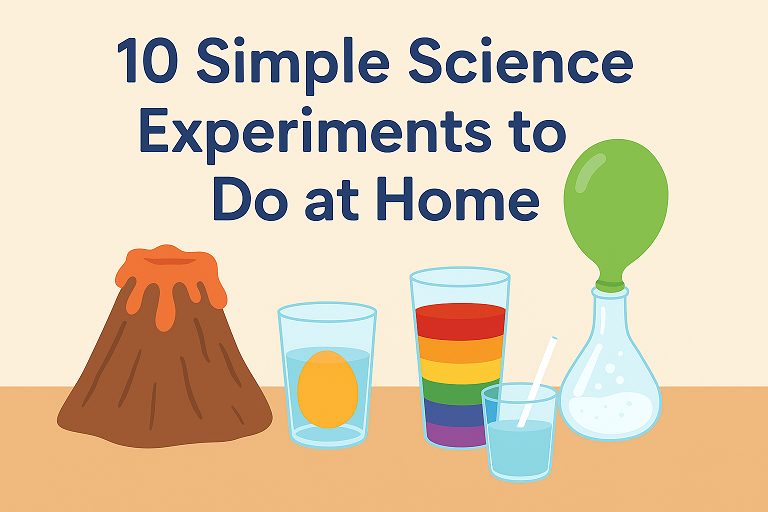Discover 10 fun and simple science experiments to do at home using everyday materials. Perfect for kids, parents, and teachers who want to make learning science exciting and hands-on.

Table of Contents
Introduction
Science is all around us, and the best way to understand it is by experimenting. You don’t need a lab or fancy equipment to enjoy the wonders of science. With a few basic household items, you can try simple science experiments to do at home that are both fun and educational. These activities are perfect for kids, parents, and even teachers looking for engaging ways to explain scientific concepts in a practical way.
Simple science experiments to do at home.
1. The Baking Soda and Vinegar Volcano
One of the most classic and exciting experiments is creating a homemade volcano. Simply fill a small container with baking soda, then slowly pour vinegar over it. The fizzing reaction occurs because of carbon dioxide gas being released. This is a great way to introduce children to the basics of chemical reactions.
2. The Floating Egg Experiment
Take two glasses of water. Add a few spoonfuls of salt to one glass and stir well. Place an egg in both glasses—one will sink while the other floats. This experiment shows how salt increases water’s density, making it easier for objects to float.
3. The Rainbow in a Glass
Using sugar, water, and food coloring, you can make a beautiful rainbow inside a glass. Mix sugar into water at different concentrations, add colors, and carefully layer them. The liquids stay separated because of varying densities. It’s a colorful way to understand density and layering.
4. The Balloon and Static Electricity
Rub a balloon against your hair or a wool sweater and then hold it close to small paper pieces. The paper will jump toward the balloon because of static electricity. This experiment introduces the concept of electrical charges in a simple and fun manner.
5. The Invisible Ink Experiment
Mix lemon juice with a little water and use a cotton swab to write on paper. Let it dry, then hold the paper near a light bulb. The hidden writing will appear because heat oxidizes the lemon juice. This simple activity shows how chemical changes can be revealed with heat.
6. The Walking Water Experiment
Place three cups in a row—one with red food coloring, one empty, and one with blue food coloring. Roll paper towels and place them between the cups. Over time, the colored water “walks” into the empty glass, mixing to form purple. This experiment explains capillary action and absorption.
7. The Dancing Raisins
Drop raisins into a glass of clear soda water. At first, they sink, but soon they start bouncing up and down. This happens because carbon dioxide bubbles stick to the raisins, lifting them to the surface, then releasing the gas so they fall again. It’s a fun way to see gas in action.
8. The Homemade Lava Lamp
Fill a clear bottle with water and vegetable oil, then add a few drops of food coloring. Drop an Alka-Seltzer tablet into the mixture, and you’ll see colorful bubbles rising and falling. This is an exciting way to demonstrate immiscible liquids and gas release.
9. The Plant Growth Experiment
Take two small plants and keep one in sunlight and the other in darkness. Observe them for a week. This simple science experiment highlights the importance of sunlight for photosynthesis and plant growth.
10. The Soap-Powered Boat
Cut a small piece of cardboard into a boat shape and place it on the water. Dab a drop of dish soap at the back, and the boat will move forward. This experiment demonstrates surface tension in water.
Conclusion
These simple science experiments to do at home are more than just fun—they spark curiosity, encourage critical thinking, and bring scientific concepts to life. Whether you are a parent, student, or teacher, these hands-on activities provide valuable learning experiences using everyday materials. Try them out, enjoy the excitement, and let science come alive in your home.
Please check our blog The 5 Layers of Earth: Hidden Wonders Revealed Beneath Your Feet
